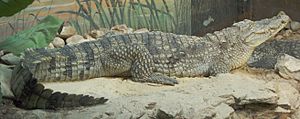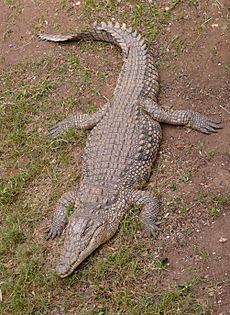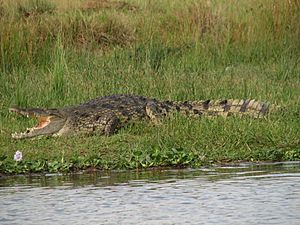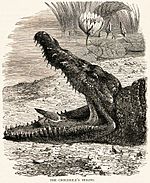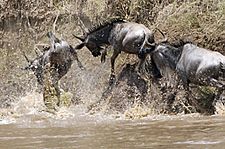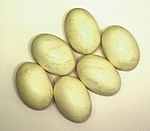Nile crocodile facts for kids
Quick facts for kids Nile crocodile |
|
|---|---|
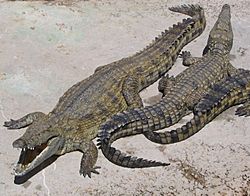 |
|
| Conservation status | |
| Scientific classification | |
| Kingdom: | |
| Class: | |
| Order: | |
| Family: | |
| Genus: | |
| Binomial name | |
| Crocodylus niloticus |
|
The Nile crocodile (Crocodylus niloticus) is the biggest of the four crocodile types found in Africa. These powerful reptiles have a long tail and very strong jaws. Their back feet are webbed, which helps them swim really well. They can grow up to 6.45 m (21.2 ft) long and weigh as much as 1,090 kg (2,400 lb). Male crocodiles are usually larger than females.
Nile crocodiles live in many different places, including lakes, rivers, and estuaries (where rivers meet the sea). You can find them across much of Africa and even in Madagascar. They used to live in places like Jordan and Israel too.
What they eat changes as they grow. Young crocodiles munch on insects and small fish. But adult crocodiles are strong enough to catch and eat large animals like zebras, antelopes, wildebeests, and even buffalo!
Contents
Nile Crocodile Features
Nile crocodiles have a dark bronze color on top, with black spots on their backs. Their bellies are a dirty purple. The sides of their bodies are yellowish-green with dark patches that look like stripes. Their color can change a bit depending on where they live. Crocodiles from fast-moving rivers are often lighter than those in lakes or swamps. They also have green eyes.
Like all crocodiles, the Nile crocodile has four short, spread-out legs. It has a long, powerful tail and a tough, scaly skin. Rows of bony plates called scutes run down its back and tail. They also have very strong jaws.
To protect their eyes, they have special clear eyelids called nictitating membranes. They also have glands that clean their eyes with tears. Their nostrils, eyes, and ears are on top of their head. This allows them to stay hidden underwater while still being able to see, hear, and breathe. Their coloring also helps them blend in. Young crocodiles are grey, multicolored, or brown, with dark bands on their tails and bodies. As they get older, they become darker, and these bands fade. Their underbelly stays yellowish-green.
Size and Growth
The Nile crocodile is the biggest crocodilian in Africa. It is the second-largest crocodilian in the world, after the saltwater crocodile. Male crocodiles are usually 3.5 to 5 m (11 ft 6 in to 16 ft 5 in) long. Very old males can grow to 5.5 m (18 ft 1 in) or even more! Female Nile crocodiles are smaller, measuring 2.4 to 3.8 m (7 ft 10 in to 12 ft 6 in). This difference in size between males and females is called sexual dimorphism. Males can be up to 30% larger than females.
A typical Nile crocodile weighs from 225 to 550 kg (496 to 1,213 lb). However, very large males can weigh 907 kg (2,000 lb) or more! The biggest male ever accurately measured was found in Tanzania. It was 6.45 m (21 ft 2 in) long and weighed about 1,090 kg (2,400 lb). There are stories of even larger crocodiles, but these are often hard to prove. One famous large crocodile, named Gustave, from Burundi, is thought to be more than 6.1 m (20 ft 0 in) long. These giant crocodiles are rare today. In the past, before a lot of hunting, there were more of them.
Nile crocodiles from cooler places, like southern Africa, tend to be smaller. They might only reach 4 m (13 ft) in length. A smaller group of crocodiles in Mali and the Sahara Desert are only 2 to 3 m (6 ft 7 in to 9 ft 10 in) long. These are now known as a separate species called the West African crocodile.
Where Nile Crocodiles Live
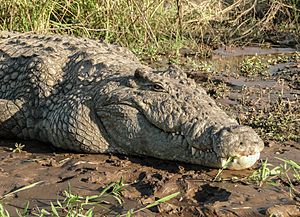
The Nile crocodile is the most common type of crocodile in Africa today. You can find them across most of the continent. In the past, they lived even further north, near the Mediterranean Sea. Today, they are common in many countries like Somalia, Ethiopia, Uganda, Kenya, Egypt, South Africa, and Madagascar.
In East Africa, they mostly live in rivers, lakes, swamps, and dams. Sometimes, they even go into the sea! One crocodile was seen 11 kilometres (6.8 mi) off the coast in 1917. In Madagascar, some Nile crocodiles have learned to live in caves.
It was once thought that Nile crocodiles lived all over West Africa. However, those populations are now known to be a different species, the West African crocodile. Interestingly, the Nile crocodile is more closely related to crocodiles found in the Americas than it is to the West African crocodile.
Nile Crocodile Behavior and Life
Nile crocodiles have a special four-chambered heart, similar to a bird's heart. This helps them get a lot of oxygen into their blood. They usually dive underwater for only a few minutes. But if they feel threatened, they can stay underwater for up to 30 minutes. If they stay very still, they can hold their breath for up to two hours! They are cold-blooded animals, which means their body temperature changes with their surroundings. This allows them to survive for a long time between meals. When they do eat, they can eat up to half their body weight at once!
They usually crawl on their bellies. But they can also "high walk," lifting their bodies off the ground. Smaller crocodiles can even gallop, and even large ones can move surprisingly fast for short bursts, reaching speeds of 12 to 14 km/h (7.5 to 8.7 mph). They swim much faster by moving their bodies and tails in a wavy motion. They can keep up this swimming speed for longer, reaching about 30 to 35 km/h (19 to 22 mph).
Nile crocodiles make many different sounds and have excellent hearing. Their skin has special sense organs that might help them feel changes in water pressure.
The bite of an adult Nile crocodile is incredibly strong, measuring about 5,000 lbf (22 kN)! However, the muscles that open their mouth are very weak. A person can easily hold a crocodile's mouth shut with just a little force. Their mouths are full of 64 to 68 cone-shaped teeth. Young crocodiles have a hard spot on their mouth called an egg tooth. They use this to break out of their eggshells when they hatch.
Crocodiles can live a long time. Larger types like the Nile crocodile might live for 70 to 100 years.
Hunting and Diet
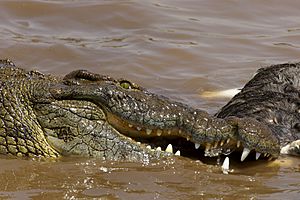
Nile crocodiles are amazing hunters. They can hunt both in and out of the water. This means they can surprise almost any animal, even those much bigger than themselves.
In the water, they are quick and agile hunters. They use their senses to find any prey that comes near the water's edge. On land, they can only rely on their legs. They can gallop on solid ground to chase prey. Most land hunting happens at night. Crocodiles will hide near forest paths or roads, sometimes up to 50 meters (170 feet) from the water.
Most land animals are caught when they come to the water to drink. The crocodile moves slowly, mostly hidden underwater, with only its eyes and nostrils showing. Then, it attacks suddenly! The crocodile lunges out of the water and grabs its prey. A crocodile's teeth are not for tearing meat. Instead, they are for sinking deep into the prey and holding on tightly. The crocodile's super strong bite ensures the prey cannot escape. Then, the crocodile uses its body strength and weight to pull the animal into the water. There, the prey is either drowned or killed by the crocodile thrashing its head. Other crocodiles might join in to help tear the prey into pieces.
The size of the prey depends on the size of the crocodile. Young hatchlings eat smaller things like small fish, frogs, insects, and tiny water creatures. As they grow, they start eating larger fish, amphibians, and small reptiles. Teenager crocodiles eat a wider range of food. This includes birds, turtles, snakes, and small to medium-sized mammals. Some examples are monkeys, duikers, rodents, mongoose, and hares. They might also snatch birds like storks or fish eagles. Crocodiles will eat fish and other small animals if larger food is not available. Large fish like catfish are preferred by adults. About 70% of a young adult crocodile's diet is still fish. But this changes a lot for full-grown adults.
Adult Nile crocodiles are apex predators, meaning they are at the top of their food chain. They hunt various birds, reptiles, and mammals. Large birds like ostriches and big snakes like pythons are some of their non-mammalian prey. For mammals, they mostly eat antelopes like gazelles, wildebeests, and zebras. Warthogs and baboons are also common prey. As crocodiles get bigger, they prefer larger prey because it gives them more energy. So, big adults rarely hunt small animals. Their diet is almost entirely made up of mammals. Very large adults sometimes hunt huge prey like giraffes, Cape buffaloes, young hippos, and young elephants. In rare cases, large crocodiles have even been seen taking down black rhinoceroses. However, these very large animals are not their usual prey.
Nile crocodiles are also known to hunt other large predators like hyenas, cheetahs, African wild dogs, leopards, and even lions sometimes. But predators are usually smarter and more careful than other prey animals. They often avoid water where crocodiles live. Crocodiles usually only attack other predators if there isn't enough regular food.
Crocodiles living near towns sometimes eat domestic animals. They are known to prey on chickens, goats, sheep, and cattle. Nile crocodiles also attack humans more often than other crocodile species.
Smaller adult Nile crocodiles use their bodies and tails to push groups of fish towards the riverbank. Then, they eat them with quick sideways snaps of their heads. They also work together! They might form a semicircle across a river to block migrating fish. The strongest crocodile eats first. Their ability to hide underwater and their speed over short distances make them excellent hunters of larger prey. They grab prey in their strong jaws, drag it into the water, and hold it underwater until it drowns.
They will also eat dead animals or steal food from other predators like lions. Groups of Nile crocodiles might travel far from the water to eat a dead animal. They also eat dead hippos together, sharing the meal. Once their prey is dead, they rip off and swallow large pieces of meat. When many crocodiles share a kill, they use each other for leverage. They bite down hard and then twist their bodies in a "death roll" to tear off big chunks of meat. They might also wedge their prey under branches or stones to help them tear it apart.
Reproduction and Life Cycle
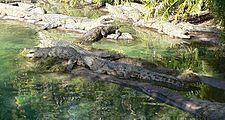
Nile crocodiles mate in the water. After mating, the female digs a hole in the ground and lays her eggs there. She can lay up to 60 eggs, which take about 90 days to hatch. The female guards the nest carefully during this time. Young crocodiles are ready to have their own babies when they are about 12 years old.
Unlike most other crocodiles, female Nile crocodiles bury their eggs in sand instead of keeping them in rotting plants. After burying the eggs, the mother guards them for about three months while they develop.
Before hatching, the baby crocodiles make high-pitched chirping sounds. This is a signal for the mother to open the nest. The parents might even pick up the eggs in their mouths and gently roll them between their tongue and the roof of their mouth to help crack the shell and release their babies. Once the eggs hatch, the female might lead the baby crocodiles to the water. She might even carry them in her mouth, just like American alligator mothers do.
The new mother will protect her babies for up to two years. If there are many nests in the same area, the mothers might form a group called a crèche to protect all the young. During this time, the mothers might carry their babies in their mouths or in a pouch under their throat to keep them safe. The mother will sometimes carry her young on her back to protect them from predators like turtles or water snakes. After two years, the baby crocodiles will be about 1.2 m (4 ft) long. They will then leave the nest area and avoid the territories of older, larger crocodiles.
Images for kids
-
A large Nile crocodile in Entebbe
-
Attacking a Burchell's zebra in Kruger National Park, South Africa
-
Large adult crocodiles in a zoo in Djerba, Tunisia
-
Nile crocodiles in a zoo in Israel
-
A barrier in Uganda to help prevent crocodile attacks.
See also
 In Spanish: Cocodrilo del Nilo para niños
In Spanish: Cocodrilo del Nilo para niños



